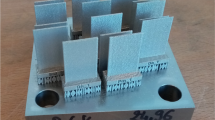Abstract
The well-known advantages of laser beam welding, like the low overall energy deposition into the welding zone or the high processing speed, have led to increased industrial use of this joining process. In order to simulate the heat input and to draw conclusions for experimental application, numerous tasks have to be performed manually. Moreover, expert knowledge is necessary to build thermal FE models of a welding process and to calibrate a heat source to reconstruct the temperature field. Hence, the automation of conventional steps can contribute to more efficient industrial use of the FE simulation. In order to more easily simulate the welding process, an approach for automating the essential steps is proposed in this paper. Thus, special attention is paid to the use of image processing tools and optimization algorithms. The application of this approach precisely depicts the heat deposition and simultaneously decreases the workload for the user.







Similar content being viewed by others
References
Belitzki A, Zaeh MF (2015) The accuracy of calculated component distortions using the weld pool length to calibrate the heat source. In: Laser Institute of America (ed) Proceedings of the 34th international congress on applications of lasers & electro-optics, vol 34. Laser Institute of America (LIA pub)
Bonnans JF (2006) Numerical optimization: theoretical and practical aspects, 2nd edn. Universitext. Springer, Berlin [u.a.]
Burger W, Burge MJ (2008) Digital image processing: an algorithmic introduction using Java. Texts in computer science. Springer, New York
Canny J (1986) A computational approach to edge detection. IEEE Trans Pattern Anal Mach Intell PAMI 8(6):679–698. doi:10.1109/TPAMI.1986.4767851
Franco A, Romoli L, Musacchio A (2014) Modelling for predicting seam geometry in laser beam welding of stainless steel. Int J Therm Sci 79:194–205. doi:10.1016/j.ijthermalsci.2014.01.003
Goldak J, Chakravarti A, Bibby M (1984) A new element model for welding heat sources. Metall Trans B 15(2):299–305
Heinze C, Schwenk C, Rethmeier M (2012) Effect of heat source configuration on the result quality of numerical calculation of welding-induced distortion. Simul Model Pract Theory 20(1):112–123. doi:10.1016/j.simpat.2011.09.004
Karkhin VA, Homich PN, Michailov VG (2007) Models for volume heat sources and functional-analytical technique for calculating the temperature fields in butt welding. In: Cerjak H, Bhadeshia H, Kozeschnik E (eds) Proceedings of the 8th international seminar numerical analysis of weldability, mathematical modelling of weld phenomena, vol 8. Verlag der Technischen Universität Graz, Graz, pp 819–833
Lanser S, Eckstein W (1991) Eine Modifikation des Deriche-Verfahrens zur Kantendetektion. In: Brauer W, Radig B (eds) Mustererkennung 1991, Informatik-Fachberichte, vol 290. Springer, Berlin, pp 151–158. doi:10.1007/978-3-662-08896-8
Otto A, Koch H, Leitz KH, Schmidt M (2011) Numerical simulations—a versatile approach for better understanding dynamics in laser material processing. Phys Procedia 12:11–20. doi:10.1016/j.phpro.2011.03.003
Pittner A (2012) A contribution to the solution of the inverse heat conduction problem in welding simulation, BAM-Dissertationsreihe, vol 85. Bundesanstalt für Materialforschung und -prüfung (BAM), Berlin
Radaj D (1999) Schweißprozesssimulation: Grundlagen und Anwendungen, Fachbuchreihe Schweisstechnik, vol. Bd. 141. Verl. für Schweißen und Verwandte Verfahren, DVS-Verl., Düsseldorf
Radaj D (2002) Eigenspannungen und Verzug beim Schweissen: Rechen-und Messverfahren, Fachbuchreihe Schweisstechnik, Bd. 143. Verlag für Schweißen und Verwandte Verfahren, DVS-Verlag, Düsseldorf
Rao SS (2009) Engineering optimization: theory and practice, 4th edn. Wiley, Hoboken
Schober A (2014) Eine Methode zur Wärmequellenkalibrierung in der Schweißstruktursimulation, Forschungsberichte iwb, vol 291. Utz Verlag, München
Zäh MF, Kronthaler M, Oefele F (2010) Bifokal-Hybrid-Laserstrahlschweißen: Eine potentialträchtige Technik zum Fügen schwer schweißbarer Aluminiumlegierungen. wt Werkstattstechn Online 100(6):454–460
Acknowledgments
This paper is partly based on investigations of the subproject B4-Simulation of the Thermal Joining of Lightweight Frame Structures—of the Transregional Collaborative Research Centre/Transregio 10, which was kindly supported by the German Research Foundation (DFG).
Author information
Authors and Affiliations
Corresponding author
Rights and permissions
About this article
Cite this article
Belitzki, A., Marder, C., Huissel, A. et al. Automated heat source calibration for the numerical simulation of laser beam welded components. Prod. Eng. Res. Devel. 10, 129–136 (2016). https://doi.org/10.1007/s11740-016-0664-9
Received:
Accepted:
Published:
Issue Date:
DOI: https://doi.org/10.1007/s11740-016-0664-9




